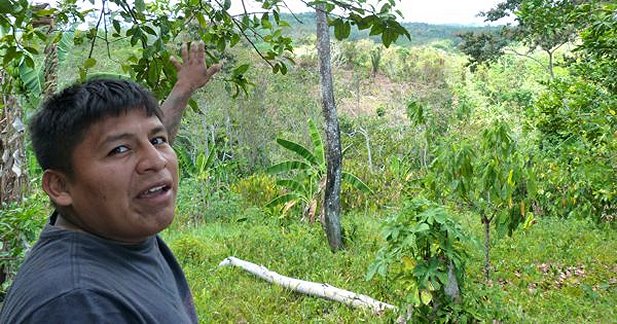
Exploring Cacao in Southern Belize
September 5, 2014
If you’re willing to fly over rain forests and aqua colored Caribbean shores in a small plane to learn more about chocolate, you may want to consider a trip to Southern Belize.
Why travel there? The Toledo District in Southern Belize has a rich cacao history (and an annual chocolate festival *). You can also experience chocolate as it originated hundreds of years ago, as a beverage and rustic confection, before European explorers arrived.
Cacao originated in Latin America; and cultivation of cacao trees has been practiced for centuries in Southern Belize, when the ancient Maya people inhabited the temple ruins still standing today. During a one week stay in Belize I felt I was traveling back in time.
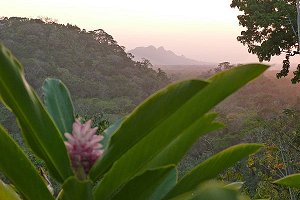 Belcampo Belize
Belcampo Belize
Starting with the present, I traveled a short distance east from the seaside town of Punta Gorda, for a tour (and overnight stay) at Belcampo Belize.
This spacious jungle and river property gives visitors insight into cacao, rum and coffee production. As an added plus, during my stay I caught glimpses of colorful birds, howler monkeys and the mist-shrouded Maya Mountains in the distance.
But, I came for the chocolate, and was not disappointed. During my time at the Belcampo Lodge, I walked down to a nursery area where I saw hundreds of thriving cacao seedlings that were being planted across 100 acres of forest canopy.
We took a walk on the “Chocolate Trail” through this forest to see the young trees. Depending on the time of year, these trees may have football-shaped cacao pods -- ready to harvest for their core of large seeds.
Later we made chocolate from scratch with modern roasters, melangers, shiny new tempering equipment at Belcampo’s new Farm and Agritourism center. (Workshops like this need to be arranged in advance.)
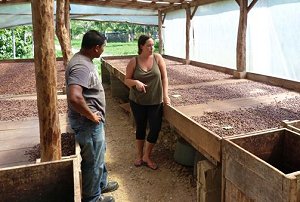 Maya Mountain Cacao
Maya Mountain Cacao
To view cacao closer to its local origins, you may also want to arrange a visit to Maya Mountain Cacao’s “Cacao House” (in San Ignacio) where respected U.S. bean-to-bar makers (Mast Brothers, Taza Chocolate, Raaka Chocolate) have visited and bought cacao beans to make high-end, single origin dark bars.
Local farmers can bring “wet” (freshly harvested) beans here. A guide may perform a “cut test” -- slicing open a few of a farmer’s fermented beans to show their heritage and quality, in shades of white, purple and pink.
After fermentation is complete, beans are dried in the sun, sorted, and sacked up for shipment to local or international chocolate makers.
If you have time to visit a few more locations, Southern Belize chocolate makers include IxCacao (San Felipe), Kakaw Chocolate (San Pedro) and Cotton Tree Chocolate (Punta Gorda). A bit further north is Goss Chocolate (Seine Bight in the Placencia Peninsula).
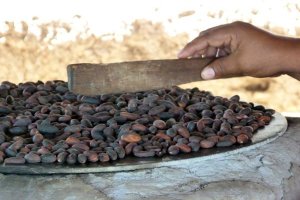 Agouti Cacao Farm
Agouti Cacao Farm
Traveling further back in time, a small group of us toured the rustic Agouti Cacao Farm (in San Pedro de Colombia), a business operated by farmer Eladio Pop (the subject of the 2011 documentary, “The Chocolate Farmer”) and his family.
We strolled through forested hillsides and sampled the white cacao fruit/pulp (that tasted a bit like Watermelon Jolly Rancher candy), freshly cut from cacao trees with a machete by our guide -- who pointed uphill to an old Mayan temple. (Farmers may have given a portion of their crops to higher ups in these temples, much as we pay taxes today.)
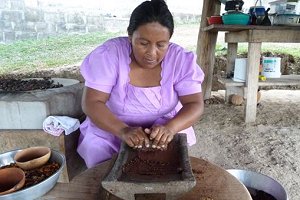 After the walking tour, we gathered under a thatch covered outdoor kitchen to watch another member of the Pop family roast lightly fermented and dried cacao beans (with a few allspice berries) over a hot comal (cooking surface over a fire), which she then stone-ground by hand into a dark, rich cacao paste.
After the walking tour, we gathered under a thatch covered outdoor kitchen to watch another member of the Pop family roast lightly fermented and dried cacao beans (with a few allspice berries) over a hot comal (cooking surface over a fire), which she then stone-ground by hand into a dark, rich cacao paste.
This cacao was mixed with boiling hot water and a bit of honey, and served to us in gourd half-shells that had been carved with images of an agouti -- a local animal that will eat cacao, and the namesake for the farm.
This hot drinking chocolate was rich and slightly smoky (likely from the fire) and spicy (allspice). The experience of being there with Eladio Pop’s family made it all the richer.
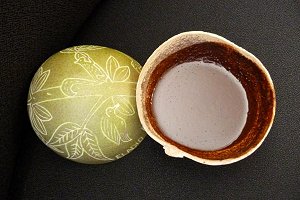 They also made a confection for us made with pressed cacao paste (sweetened with honey), and a coconut version with cacao nibs. This is likely what the first chocolates may have tasted like.
They also made a confection for us made with pressed cacao paste (sweetened with honey), and a coconut version with cacao nibs. This is likely what the first chocolates may have tasted like.
For more information on a chocolate trip to Belize, contact:
- Winter Chocolate Events and Escapes - January 30, 2015
- The Versatility of Chocolate - October 3, 2014
- Exploring Cacao in Southern Belize - September 5, 2014

